AMD’s Jaguar Architecture: The CPU Powering Xbox One, PlayStation 4, Kabini & Temash
by Anand Lal Shimpi on May 23, 2013 12:00 AM ESTKabini: Mainstream APU for Notebooks
AMD will be building two APUs based on Jaguar: Kabini and Temash. Kabini is AMD’s mainstream APU, which you can expect to see in ultra-thin affordable notebooks. Note that both of these are full blown SoCs by conventional definitions - the IO hub is integrated into the monolithic die. Kabini ends up being the first quad-core x86 SoC if we go by that definition.
Kabini will carry A and E series branding, and will be available in a full quad-core version (A series) as well as dual-core (E series). The list of Kabini parts launching is below:
On the GPU side we have a 2 Compute Unit implementation of AMD’s Graphics Core Next architecture. The geometry engine has been culled a bit (1/4 primitive per clock) in order to make the transition into these smaller/low cost APUs. Double precision is supported at 1/16 rate, although adds and some muls will run at 1/8 the single precision rate.
Kabini features a single 64-bit DDR3 memory controller and ranges in TDPs from 9W to 25W. Although Jaguar supports dynamic frequency boosting (aka Turbo mode), the feature isn’t present/enabled on Kabini - all of the CPU clocks noted in the table above are the highest you’ll see regardless of core activity.
We have a separate review focusing on the performance of AMD’s A4-5000 Kabini APU live today as well.
Temash: Entry Level APU for Tablets
While Kabini will go into more traditional notebook designs, Temash will head down into the tablet space. The Temash TDPs range from 3.9W all the way up to 9W. Of the three Temash parts launching today, two are dual-core designs with the highest end A6-1450 boasting 4 cores as well as support for turbo core. The A6-1450’s turbo core implementation also enables TDP sharing between the CPU and GPU cores (idle CPUs can be power gated and their thermal budget given to the GPU, and vice versa).
The A4-1200 is quite interesting as it carries a sub-4W TDP, low enough to make it into an iPad-like form factor. It’s also important to note that AMD doesn’t actually reduce the number of GPU cores in any of the Temash designs, it just scales down clock speed.
Xbox One & PlayStation 4
In both our Xbox One and PS4 articles I referred to the SoCs as using two Jaguar compute units - now you can understand why. Both designs incorporate two quad-core Jaguar modules, each with their own shared 2MB L2 cache. Communication between the modules isn’t ideal, so we’ll likely see both consoles prefer that related tasks run on the same module.
Looking at Kabini, we have a good idea of the dynamic range for Jaguar on TSMC’s 28nm process: 1GHz - 2GHz. Right around 1.6GHz seems to be the sweet spot, as going to 2GHz requires a 66% increase in TDP.
The major change between AMD’s Temash/Kabini Jaguar implementations as what’s done in the consoles is really all of the unified memory addressing work and any coherency that’s supported on the platforms. Memory buses are obviously very different as well, but the CPU cores themselves are pretty much identical to what we’ve outlined here.


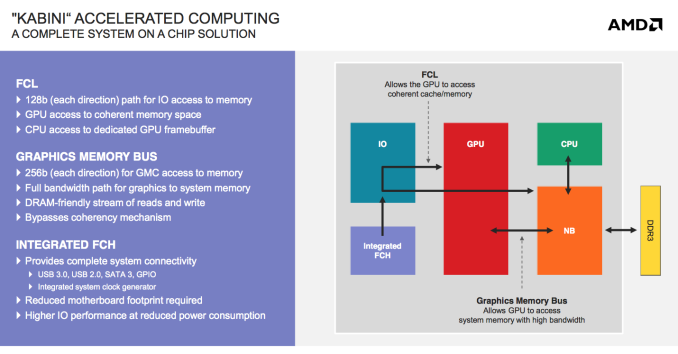
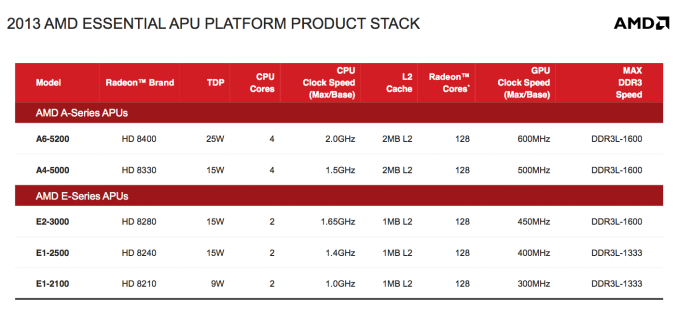


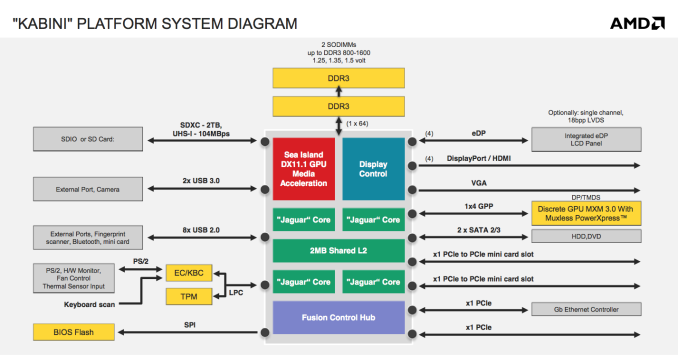
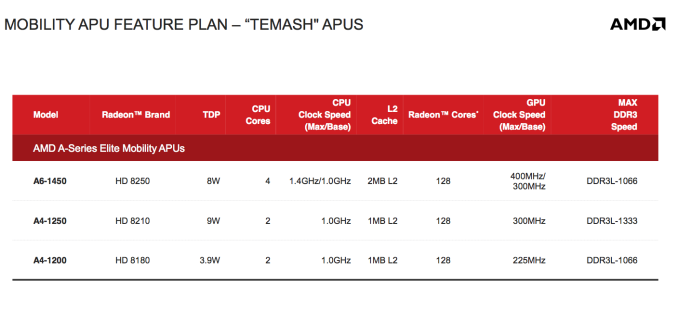
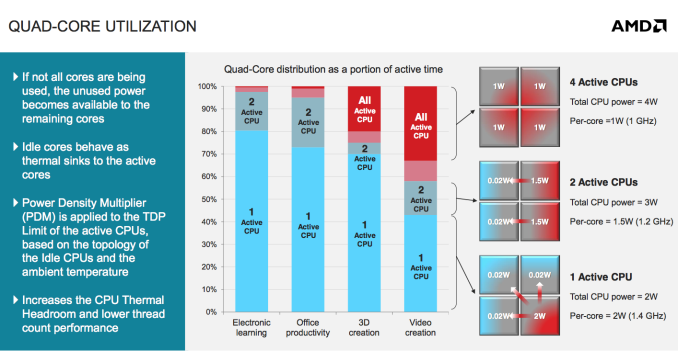








78 Comments
View All Comments
Krysto - Friday, May 24, 2013 - link
Still don't see why OEM's would choose AMD's APU's in Android tablets over ARM, though.It's weaker CPU wise, and most likely weaker GPU wise, too. We'll see when they come out if their GPU's can stand up to Adreno 330, PowerVR Series 6 and Mali T628. Plus, it requires quite a bit of power.
In my book no chip that can't be used in a smartphone (and I'm talking about the exact same model, not the "brand") should be called a "mobile chip".
This idea about "tablet chips" is nonsense. Tablet chips is just another way of saying our chip is not efficient enough, so we're just going to compensate for that with a much larger battery, that adds more to weight, charging time, and of course price.
ReverendDC - Monday, May 27, 2013 - link
Even an Atom chip is more powerful per cycle than ARM, and AMD's stuff is more powerful than Atom. I'm not exactly sure what you are using to state that ARM is more powerful, but AnandTech did a great comparison themselves.By the way, the comparisons in some cases are for quad core ARM vs. single core Atom at comparable speeds. Again, really not sure where your "facts" come from.
BernardBlack - Wednesday, May 29, 2013 - link
ARM actually isn't all that...and it's quite the other way around.As I have seen it stated elsewhere, "Simply: x86 IPC eats ARM for lunch while actual performance and power usage will scale together. That is why ARM currently has no real business competing against x86"
BernardBlack - Wednesday, May 29, 2013 - link
It's all about instructions per cycle and that is what AMD and Intel do best.BernardBlack - Wednesday, May 29, 2013 - link
not to mention, the IPC's in these processors follow suit with their server Opteron processors, which means, they achieve even greater IPC's per cycle. This is how you are able to have 1.6ghz CPU's that can compete with many common 3-4ghz desktop processors.eanazag - Friday, May 31, 2013 - link
They could use the exact same hardware design to sell Android and Windows tablets.Wolfpup - Wednesday, June 12, 2013 - link
Huh? AMD's Bobcat parts are more powerful than ARM's stuff. ARM's only just now managing to sort of compete with first gen Atom at best, and that with a CPU that's not actually used in much.And "tablet chips" is NOT nonsense. You have more power budget, and higher expectations for performance in a tablet. If it's "nonsense", why does Apple put bigger chips in their tablets? Why can tablets run Core i CPUs? Why do they typically get bigger chips first even with Android?
Wolfpup - Wednesday, June 12, 2013 - link
To add to that, THIS article explicitly says "Jaguar is presently without competition...nothing from ARM is quick enough."So really, where the heck are you getting the idea ARM has more powerful chips?
kyuu - Thursday, May 23, 2013 - link
I think the main point of this is getting into the mobile market. Temash looks like a great chip for a tablet. The only problem is OEMs not biting because they think they have to put an Intel sticker on the box for it to sell.Personally, I'm waiting on a good tablet with Temash to finally jump into the Win8 tablet club. Whatever OEM makes a good one first will be getting my money.
mikato - Friday, May 24, 2013 - link
I think with tablets, OEMs are even less likely to think they need to put an Intel sticker on it. Joe Schmo knows Intel doesn't mean as much for tablets. The most well known tablets aren't Intel. This is an opening for AMD to be able to get in the game late if they want to.Actually, do they even put stickers on tablets?